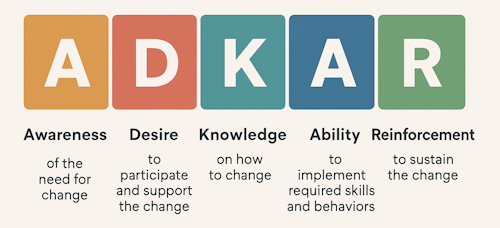ADKAR
Maps change into five actionable building blocks: Awareness to Reinforcement.
"Change is not about organizations changing. It's about individuals changing one at a time."

In Agile organizations, change is not just common, it's constant. Yet despite best intentions, many Agile transformations falter due to human resistance. The ADKAR model, developed by Prosci founder Jeff Hiatt, is a change management framework that focuses on guiding individuals through change. Its name is an acronym that represents the five outcomes people need to achieve for change to succeed: Awareness, Desire, Knowledge, Ability, and Reinforcement.
By applying ADKAR, Agile leaders and coaches can better manage the people side of change, bridging the gap between new ways of working and actual adoption by individuals and teams.
Impact on Agile Organizations
The ADKAR model aligns well with Agile principles because both value individuals and interactions. However, Agile practices like continuous delivery, iterative planning, and cross-functional teams often require shifts in mindset, roles, and behaviors. When organizations ignore these human factors, Agile adoptions stall or degrade into "mechanical Scrum" or "fake Agile".
ADKAR helps identify where resistance occurs and provides a structured approach to overcome it, ensuring lasting change. It clarifies that transformation doesn't fail at the organizational level, it fails when individuals don't transition effectively.
Scenario
Imagine a large organization launching a SAFe implementation. Leadership has invested in training and tooling. Agile Release Trains are formed, backlogs are created, and PI Planning begins. But several months in, teams are disengaged, Product Owners still escalate all decisions to managers, and Scrum Masters struggle to facilitate change.
A Retrospective reveals:
- Awareness was low: Many didn't understand why the shift was happening.
- Desire was absent: Teams felt Agile was just "another top-down initiative".
- Knowledge was inconsistent: Training wasn't tailored to roles.
- Ability lacked: Old habits persisted under pressure.
- Reinforcement was missing: Successes weren't celebrated or sustained.
Despite a well-intentioned rollout, the transformation failed to move hearts and minds.
Ways to Mitigate Challenges in Each Step:
- Awareness:
- Start every Agile transformation by clearly communicating the why. Use storytelling, business context, and urgency to connect emotionally.
- Desire:
- Involve people early. Let teams co-create working agreements and define how Agile will improve their lives, not just meet business goals.
- Knowledge:
- Offer role-specific training and mentorship. A generic Agile course is not enough for deep practice.
- Ability:
- Create safe spaces for experimentation. Pairing, coaching, and job aids help bridge the gap from theory to daily behavior.
- Reinforcement:
- Recognize progress visibly. Celebrate wins. Embed Agile practices into performance reviews, team rituals, and leadership expectations.
Agile coaches can use ADKAR as a diagnostic tool to assess where resistance lies and customize interventions accordingly.
Conclusion:
ADKAR when paired with Agile principles, can help equip leaders to deal with the human complexity of change. Agile isn't adopted by declaring new frameworks or holding training sessions, it's adopted by helping people believe in and embody new ways of thinking and working. ADKAR provides that map.
Key Takeaways
- ADKAR (Awareness, Desire, Knowledge, Ability, Reinforcement) is a people-centered change model.
- Agile transformation success depends on individual adoption, not just structural rollout.
- Each element of ADKAR can reveal hidden blockers to Agile change.
- Agile coaches can use ADKAR to personalize coaching and support across roles and teams.
- Integrating ADKAR with Agile ensures lasting cultural shifts, not just temporary compliance.
Summary
Agile transformations often fail not due to poor strategy or tools, but because individuals resist change. The ADKAR model offers a human-focused lens to guide individuals through transformation. By addressing Awareness, Desire, Knowledge, Ability, and Reinforcement, Agile coaches and leaders can foster genuine behavioral change that anchors Agile principles in the culture of the organization. In short, ADKAR brings humanity to agility.